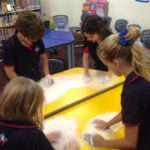Lesson Overview:
In this lesson, students learn what plants need to grow. This is a very simplified “plant life cycle” lesson, but with a darling literature link. Do plants eat pizza, cheeseburgers, or ice cream? Have your students discover what plants need to thrive, then complete a simple drawing to show their understanding.
Lesson Plan:
Suggested Grades:
K–1
Objective:
To know that plants need soil, water, and sunshine to grow. (AASL 4.1.8, “Use creative and artistic formats to express personal learning.”)
Suggested Time:
35-40 minutes
Success Criteria:
Each student will complete a series of three simple, labeled drawings to show their understanding of what plants need to grow.
Lesson Outline:
1. Introduction:
Remind the students that they are learning about life cycles. They have looked at the human life cycle, including infants and growing children. Explain that today they will look briefly at how plants grow.
- Ask students if they have ever planted a seed. What happened?
- Ask students if they have ever seen a large tree. How did that tree begin its life? Was the tree always big?
- Ask students what a plant needs to change from a seed into a plant. (This will assess how much they already know.)
2. Main:
Tell the students that today they are going to read a story about a little girl named Fran. Fran, unfortunately, did not understand much about lifecycles!
Share the story of Fran and her flower. Follow up with thinking questions such as:
- What did Fran think her flower needed to grow?
- What did Fran’s flower really need to grow?
- What do the plants in our neighborhood need to grow?
- What would happen if you tried to feed your bushes, trees, or flowers people food?
- Why did Fran’s flower start to grow once she put it outside?
- How is a plant’s life cycle like a person’s life cycle?
- How is a plant’s life cycle different from a person’s life cycle?
Explain the assignment to the students. Hold up an assignment sheet and talk through the “What I’m looking for” statement as well as the instructions. The children should be able to say right away that a plant needs:
- Soil
- Sun and Fresh Air
- Rain
to grow. Ask them to sketch simple pictures of Fran’s flower (or any plant of their choosing) getting the things it needs to grow. If they need it, help the children label their drawings.
3. Conclusion:
Show the children some books from the library’s collection about plants. Encourage them to read about different kinds of plants and find out more about plant life cycles. Fran’s flower was a simple story, but there is much more we can learn about plants in our world. Scientists who study plans are called botanists. Be a botanist and learn a few more things about plants by checking out some of the library’s plant-themed books.
Resources:
- Fran’s Flower by Lisa Bruce and Rosalind Beardshaw.
- Copies of Student Handout (attached).
- Colored pencils, crayons, markers, etc.
- Soil, egg cartons, and seeds (optional)
- A collection of the library’s books about flowers, trees, and plants (nonfiction).
Notes:
Although Fran’s Flower is a simple story, I find that the kids get a big kick out of it. I love teaching this lesson because it is easy to understand, easy to prepare, and EAL-friendly, and I can pull it out quickly if one of my periods gets cut short and I need a shorter-than-normal kid-pleaser. The lesson can also easily be used in any lesson on the environment, living vs nonliving things, or even a seasonal lesson at springtime.
If you want, you can easily expand this lesson by having the children plant seeds. I usually don’t do that, however, because the homeroom teachers almost always do! If the homeroom teachers have kids working with plants that were bought as young plants, and if the kids have never planted a seed, be sure to plant seeds with them. A couple of seed packets, one package of potting soil, and some thrift-store pots or old mugs, and you’re all set!
Recommended books for this lesson:
Fran’s Flower by Lisa Bruce and Rosalind Beardshaw
Key Terms:
Flowers, Plants, Life Cycles, Growth (Plants)

